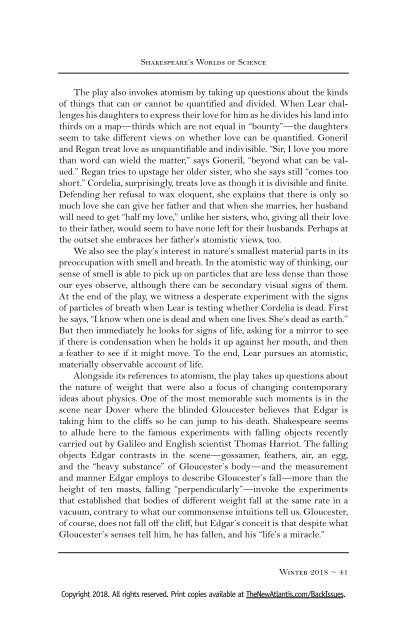The New Atlantis - Winter 2018 (Issue 54) uncompressed with cover
Create successful ePaper yourself
Turn your PDF publications into a flip-book with our unique Google optimized e-Paper software.
Shakespeare’s Worlds of Science<br />
<strong>The</strong> play also invokes atomism by taking up questions about the kinds<br />
of things that can or cannot be quantified and divided. When Lear challenges<br />
his daughters to express their love for him as he divides his land into<br />
thirds on a map — thirds which are not equal in “bounty” — the daughters<br />
seem to take different views on whether love can be quantified. Goneril<br />
and Regan treat love as unquantifiable and indivisible. “Sir, I love you more<br />
than word can wield the matter,” says Goneril, “beyond what can be valued.”<br />
Regan tries to upstage her older sister, who she says still “comes too<br />
short.” Cordelia, surprisingly, treats love as though it is divisible and finite.<br />
Defending her refusal to wax eloquent, she explains that there is only so<br />
much love she can give her father and that when she marries, her husband<br />
will need to get “half my love,” unlike her sisters, who, giving all their love<br />
to their father, would seem to have none left for their husbands. Perhaps at<br />
the outset she embraces her father’s atomistic views, too.<br />
We also see the play’s interest in nature’s smallest material parts in its<br />
preoccupation <strong>with</strong> smell and breath. In the atomistic way of thinking, our<br />
sense of smell is able to pick up on particles that are less dense than those<br />
our eyes observe, although there can be secondary visual signs of them.<br />
At the end of the play, we witness a desperate experiment <strong>with</strong> the signs<br />
of particles of breath when Lear is testing whether Cordelia is dead. First<br />
he says, “I know when one is dead and when one lives. She’s dead as earth.”<br />
But then immediately he looks for signs of life, asking for a mirror to see<br />
if there is condensation when he holds it up against her mouth, and then<br />
a feather to see if it might move. To the end, Lear pursues an atomistic,<br />
materially observable account of life.<br />
Alongside its references to atomism, the play takes up questions about<br />
the nature of weight that were also a focus of changing contemporary<br />
ideas about physics. One of the most memorable such moments is in the<br />
scene near Dover where the blinded Gloucester believes that Edgar is<br />
taking him to the cliffs so he can jump to his death. Shakespeare seems<br />
to allude here to the famous experiments <strong>with</strong> falling objects recently<br />
carried out by Galileo and English scientist Thomas Harriot. <strong>The</strong> falling<br />
objects Edgar contrasts in the scene — gossamer, feathers, air, an egg,<br />
and the “heavy substance” of Gloucester’s body — and the measurement<br />
and manner Edgar employs to describe Gloucester’s fall — more than the<br />
height of ten masts, falling “perpendicularly” — invoke the experiments<br />
that established that bodies of different weight fall at the same rate in a<br />
vacuum, contrary to what our commonsense intuitions tell us. Gloucester,<br />
of course, does not fall off the cliff, but Edgar’s conceit is that despite what<br />
Gloucester’s senses tell him, he has fallen, and his “life’s a miracle.”<br />
<strong>Winter</strong> <strong>2018</strong> ~ 41<br />
Copyright <strong>2018</strong>. All rights reserved. Print copies available at <strong>The</strong><strong>New</strong><strong>Atlantis</strong>.com/Back<strong>Issue</strong>s.


